
The gluteus medius is the Jan Brady of the gluteals. I’m sure if it could talk it would say “Maximus, maximus, maximus” – everyone is only concerned about sculpting a perfectly shaped J.Lo bottom. But strengthening the gluteus medius can stabilize the hip in walking and balancing, and help maintain healthy knees.
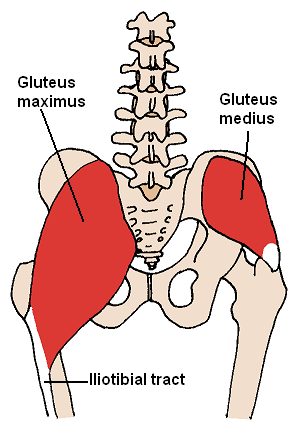
The action of the gluteus medius is to abduct the hip, the anterior fibers flex and medially rotate the hip, while the posterior fibers extend and laterally rotate the hip. Weakness in the gluteus medius is caused by poor posture and under use of the muscles during walking and running. Many other muscles, including the Quadratus Lumborum, will begin to take over for the action of the gluteus medius, resulting in low back pain and and an unstable pelvis.
It is important during walking to be strong so the pelvis does not drop or sag to one side, which can lead to pelvic instability, or possibly Trendelenburg Gait, when the torso laterally deviates to find balance over the leg since the muscles can’t support it and the foot drops during walking. The can lead to low back pain, breathing problems, knee alignment problems.
There are many corrective exercises to regain strength in the gluteus medius, taking it out of the shadows of its bigger sibling, gluteus maximus.
1) Yoga Tune Up® Abductor Lifts (dynamic and static)
2) Yoga Tune Up® Moon Rise Minivini
3) Yoga Tune Up® Magician’s Assistant on Ledge with hip abduction
Once awakened, the gluteus medius no longer has to live in the shadows, but rather be strong in its importance as part of the entire gluteal system.
Watch the QuickFix Hips Online Video
Read more posts on hips and glutes


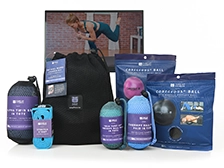
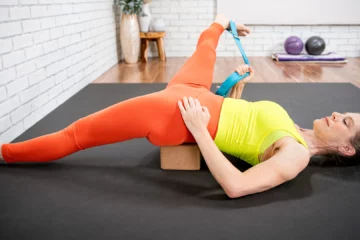

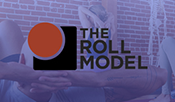
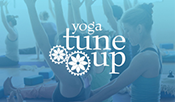


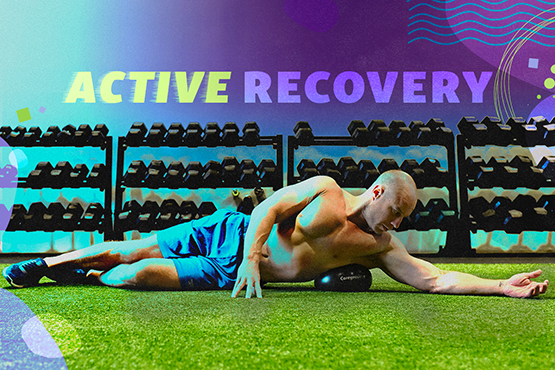
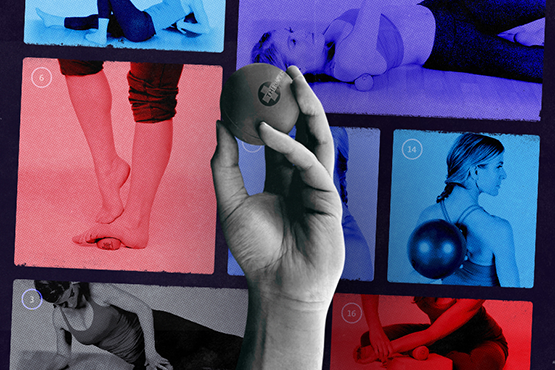
‘Maximus, Maximus, Maximus!” love it. Glutes in general are a tough one for me to get firing, but, especially, poor, forgotten little glute med…
Good article. It’s interesting that the glut med can cause knee pain. Most people with knee pain are surprised to hear that. Thanks for the exercises.
Maximus, Maximus, maximus! lol For years my yoga practice was lacking gluteus medius work. It was alllll stretching. I am so happy to have found some strengthening options through my YTU level one training!
All Hail the Gluteus Medias! Whenever I teach any type of abductor work, students freak out. So, my take is that everyone needs much more of it!!
I learn from previous article about the gluteus medius help the pelvis stabilization and extend the knowledge of weak gluteus medius is going to affect the Quardratus Lumborum—result to have lower back pain and unstable pelvis.
Important indeed! As Shakira says the hips don’t lie
It seems counterintuitive that the gluten can be weak when they are used every time a person walks . . . but then, maybe therein lies the problem! Sedentary lifestyle, flat flat walking surfaces, hard sole lifted heel shoes – what more could we ask for! Thanks for the great article.
My gluts are very week especially on my right side and I’m usually in pain in my lower back after walking sometimes just doing my grocery shopping. Since I’ve been strengthening them I’ve noticed quite a difference. Thank you for the info!
Thank you Nicole! I am a runner and I will apply your exercises to strengthen my buttocks
Thank you, Nicole, for this information and the reminder of the importance of the gluteus medius for hip and lower back health, especially in daily and frequent movement patterns such as walking, which only becomes even more important when similar movement patterns, like running, are taken to the endurance level.
Hi Nicole, Great article to summarize what we’ve been learning about the gluteus medius in Level I training. This is one small muscle with a powerful ability to correct my overused quadratus lumborum – it was good to have that fact re-emphasized in this article. No wonder moon rises were so hard for me! I can’t wait to ask you to demonstrate what Trendelenburg gait looks like in class today. 🙂
The Moonrise Minivini was a eye-opener for me! I knew that my hips were tight and not particularly strong in adduction or abduction, but the stark difference between my left and right sides was really shocking. Clearly, this is one area I need to work on. Thanks!
P.S. The Jan Brady reference is fantastic!
I am guilty of thinking a lot about the maximus! This is a great way to work and bring some solutions to low back pain and pelvis instability which is so prevalent, so I’m going to incorporate more Moon Rise- MInivini’s. Go Gluteus Medius! Thanks Nicole.
Thank you Nicole for an awesome article. So excited to teach tomorrow about gluteus medius. I ♡ moon rises. They have helped my hip/low back dysfunction greatly.
As someone who has struggled at times in lunging balancing poses, I always thought it was just something “wrong” with, or “bad” about my balance. Having started using these exercises and adding therapy balls into my practice for really just strengthening and tension relief, I had noticed that my balance was getting better. But, I hadn’t put two and two together to realize that my glute med was probably the major culprit all along. Thanks for the insight, and bringing better balance to my understanding of its key role.
Good to know about that Quadratus Lumborum taking over, I had already started using more my gluteus medius, good to hear there are even more benefits to reap out of it!
Very interesting to see the importance of the gluteus medius in particular for people who have a difficulties to stabilise hips when they walt.
Interesting – I love people watching, especially feet after taking my yoga training, now I will be watching feet and pelvis to see what is going on.
Worked on our glutes yesterday and I found more tender spots than I thought I would have (and I don’t believe we went that deep).
This definitely shines a light on the gluteus medius! It is funny how it plays such an important role yet we all pay no attention to it. I hadn’t really thought of how much it effects our stride and well being. Once again, it starts with creating awareness!!
It’s definitely not as sexy of a muscle as the gluteus maximus– but I think a key lesson of YTU is that we can’t neglect these other key muscles or they become causes of pain. As you call out in the article, weak glute med can be result of increased work for the QL and low back pain– something I think all of us want to avoid!
This is so great! Love the Brady bunch reference! Glute Med is also a super important muscle for those who are recovering from Hip replacement to get firing! Will be sharing this post with my step-mother who is in training now for her Glutes. Thanks Nicole!
Loved this one!!! I’ve never realized how numb my butt was until I put the YTU Therapy balls there and felt nothing. Not because my gluteus were super relaxed but because they were numb not even tensioned but numb. After a few rounds of rolling the YTU Therapy balls I strarted to feel my gluteus and how much they have been neglected for years of sitting down and not using them for the purpose they were made for.
I’ve been working on my gluteus now and it has done a lot to my posture, pelvis but also for my legs. Also, as my pelvis is more stable, I find my self to be more upright so my psoas is now more active and having a great stretch so I find more space in my torso. Thanks for posting this, it is a great article, funny, easy to read but full of great info.
This is great! The glutes are the new abs! They are finally getting the attention they deserve and this was a great focus on the glut medius which is definitely overlooked. Thanks for the great info on the importance of this muscle.
Haha, great reference to the brady bunch! This blog is one of my favourites, I love the way you clearly describe the function of the gluts, why we want to build the glut med and what action steps to take. Will be sharing this one!
Thanks for the article Nicole! Unsung hero and also sometimes extremely tender spot. I noticed my hips loosened up quite a bit after turning attention to the gluteus medius. Sometimes giving attention to the Jans pays larger dividends than always pursuing the Marshas.
These are all such great exercises for the Glut med. even though not Yoga Tune Up ® , another great exercise are 1 legged asymmetrical squats, where the leg that is in hip extension is adducted 30degrees i(behind you and across the midline) . That hip will depress and as you bring the back leg tthrough to hip and knee flexion (tucked) the asis level out again, strengthening the glut med of the squating leg.
Gluteus medius is the culprit for alot of knee pain, especially in runners… check for that Trendelberg!!
Whoops. Now I see where comments appear.
Too funny
(need sugar).
Hee Hee. Gluteus Medius is indeed like Jan Brady–because she lives overshadowed by her showier sibling.
But because of Gluteus Medius’ clever multi-tasking abilities, I have often thought of it as the hardworking mother of Buttocks family.
The poses that you included–Moon Rise Minivini and the Abductor Lifts–are my new broccoli and spinach. I will be taking a daily dose of them hoping to please “mother medius.”
Thank you for supporting your thoughts with specific YTU poses and movements. The Moon Rise Minivini and the Abductor Lifts are my new spinach and broccoli; I will try to take a daily helping of them to see how they please “mother medius.”
connecting the dots between the QL and the Glute Medius was something I had not thought of before. over the last year I have been doing a lot more work with glute medius and I had noticed more freedom in my low back, and my adductor longus muscles are not as restrictive. & thank you for the video! I am looking forward to trying out the corrective excersizes you mentioned.
Thanks for sharing! Your pointer about the QL taking over for a weak gluteus medius set off a light bulb for me, as I have seen the combination of weak gluteus medius and tight QL several times in clients. Always helpful to have someone else step back for you to connect the dots!
Informative and easy to understand. Since I am new at this I found this very easy to understand and use in my practice and every day life. I will be paying more attention to my gluteus medius from now on. I found it very useful that you listed some poses to work on to strengthen and stretch the musle
I am excited to learn anything that will help the knees! Thank you for this sequence that targets the gluteus medius and likely will improve the health of the knees as well!
This is such a cute and informative article!! The metaphors are on point 🙂 As a butt person, I love the gluteus medius and the suggested YTU exercises! In my classes this past week the theme was to ‘stand in poised in your truth’; even, stable and strong on all sides of the body ~ along the four sides of the legs, the seams of the torso, with the upper body even over the lower body with a stable and supple pelvis. Needless to say the gluteus medius was exercised in almost every exercise 🙂 incorporated the Yoga Tune Up Prasarita Lunges, YTU Moon Rises Mini Vini, YTU Assymetrical Uttanasana, and YTY Assymetrical Triangel, Pyramid and Reverse Triangle. I felt it very effective in educating the body’s pelvis and hips on how to stabilize during these yoga poses and how to safely lift the torso back up from the floor, by engaging the gluteus medius!! It’s all about the medius 😉
My posterual bad habit was dumping all my weight into my left hip started when my daughter was born. When I would carry her around I would use my left hip as kind of a ledge that I could rest her on. I’m sure that thrusting my hip to one side is what led to my left gluteus muscles( especially the piriformis) tightness and twinginess in my left knee. Now knowing that streughtening the Gluteus Medius is so important in stabilizing the hip while standing, walking, and balancing I have been on a mission to add corrective exercises like my new favorite YTU poses, Abductor Lifts and Moonrises into my daily routine.
Yes the gluteus medius is an important muscle to strengthen it can cause both poor knee alignment and a tight IT band when not happy. I plan to incorporate Moon rises into my regular routine.
Thank you for the great Jan Brady reference – it really is the overlooked gluteus. And when it’s not properly looked after it really likes to complain and cause serious pain. I have discovered a weakness in my left gluteus medius through moon rises and really understand now how that contributes to the lower back pain and tightness I often feel in on my left side.
This post is yet another reminder of why I am so in love with YTU and its community of teachers, I am learning so much. I have never heard of Trendelenburg Gait but after seeing some examples on YouTube I can’t imagine living with it. I can see how this would contribute to a plethora of problems. I recently showed my daughter how to do abductor lifts and I was amazed at how weak her abductor muscles were. She in toes on one side of her body caused by internal rotation at the hip joint. With very tight adductors and weak abductors she has her work cut out for her. Thank you for your post.
Thanks Nicole,
This is a great article. I’ve included prasarita lunges in my practice for sometime now. It wasn’t until recently, however, that I realized the potential gold mine that this pose holds for knee health. Thanks to poses like this and work with YTU balls, my gracilis will never be the same. Thank goodness. I looked for your first article on the gluteals and couldn’t find it. I’ll keep looking.
So is the extended lifted leg working both the anterior and posterior muscle fibers of the gluteus medius by medial and lateral rotation or is the medial rotation on adduction of the lifted leg?? and the standing flexed leg being in external rotation is in flexion and abduction?
Thanks
Over the past couple of years I have been sitting more and more at my desk for work and have been experiencing increased hip pain, especially on the right side. The YTU balls have helped tremendously to identify and release tension and tightness in my glute medius and other supporting hip muscles (e.g., TFL, glute max, etc.), but I’ve been discovering more recently that these muscles have become weak from sitting and also because I have not been rock climbing, hiking or going to the gym as much over the past year. Thanks very much for the suggested corrective exercises for strengthening these hip stabilizing muscles. I love learning new and effective YTU exercises and will continue to explore.
Thanks for this Nicole! A weak glut med can also contribute to tight and overworked TFL, placing extra stress on the IT band. Here’s a link to an article discussing this issue! http://breakingmuscle.com/mobility-recovery/your-it-band-is-not-the-enemy-but-maybe-your-foam-roller-is
This is a great post about the gluteus Medius. I am going to use this in my classes to stress how important it is that we work on strengthening the gluteus medius.
This is a really important article Nicole. I don’t know many people who treat their Glute med with the attention it deserves! Strengthening it has personally helped me get in much better positions and allowed me to maintain abduction of the hips and prevent caving or adduction of the knees during squatting. I preach the importance of a strong side-butt to a lot of people I meet in passing who complain about abduction issues and “tight IT bands”
Stephanie: I love glute med work. Magician’s Assistant on a block can be found on Jill’s Coregous DVD. If you haven’t gotten it yet – it is a MUST. Hope to see you soon.
Thanks Nicole! I have been trying to focus on strengthening the medius to see if recent knee pain could be a symptom of this weaker muscle. What is the Yoga Tune Up® Magician’s Assistant on Ledge with hip abduction? I’d love to try it.
I found this article interesting because of the ripple effect through the hips, knees and even low back that neglecting the gluteus medius can create. I am a perpetrator of favoring the importance of the glut max as the “star” of the show, since it is so superficial and ever-present in our minds as the asset muscle of the body. As a runner, I am always tight in my hips, and as a 6ft female, I am also a longtime slouched sitter (but let’s face it, we all are), and I love finding new ways to improve my knee, hip and low back health. I am continually surprised by the smaller (or medium) aspects of my musculature that play such important roles in stabilizing and strengthening my gait. The gluteus medius is a perfect example of finding muscle that is an unsung hero of posture and stability, and also a great place to start balancing your body for optimum cooperation with the more visible and popular muscles of the body.
I am glad to be reminded about the glut med because my mom who is 90years old was at the doctor recently, and her doctor asked her to walk away down the hallway. When she walked, the doctor pointed out to me that she was adductiing past the midline on both sides. This is a common weakness for elderly population. Glut med is ,in gait, primarily responsible for keeping the pelvis level during gait. Must be strengthened to increase stability in the hip and facilitate better balance.
~Sara
Thanks for this thoughtful explanation of the Gluteus Medius Nicole, and how important it is for stable hips. You did a great job of articulating that it is a busy muscle with many functions, and if not properly prepped to fire, other muscles will take over the action(s). As I notice that I am typing with my left legged crossed over my right, a position I often default to when seated, you have me wondering if that could be a major contributing factor to my stiff QL on my left. Hum… thanks for another piece of the puzzle 😉
Ever since my ACL strain I have realized just how weak my glute med is.Thanks for the awesome added information and different exercises to try and strengthen this bugger. Magician’s Assistant on a ledge really makes is burn!
I LOVE the Brady analogy! This post was helpful in my understanding of my own knee issues, as I need to strengthen all my gluteus muscles and understanding how they work together is important! Thank you!
What an informative article! It was very interesting to read about how the Gluteus Medius can play a role in maintaining healthy hips and knees. Today I did Yoga Tune Up adductor lifts for the first time, and it turns out my Gluteus Medius has not been getting the love and attention it deserves. Thanks for highlighting why it is so important!
I liked this article and enjoyed reading the comments! I have had a curiosity to learn about the function of the Gluteal muscles in relationship to supporting and stabilizing the balance of the hips. I have experienced low back pain and sciatica and have had a feeling that it is this area that i needed to target in strengthening. Good to know that it just might be specifically the Gluteus Medius! I am looking forward to learning the yoga tune up adductor lifts (static and dynamic), Moon Rise Minivini and Magician’s assist on ledge with abduction. Thank You!
Thanks for the information Nicole. I have become more shackled to my desk this past year, more sedentary, longer hours at the computer and starting to have major hip and knee pain. I know I have arthritis in the knees, but trying to undersstand what is going on with pain in hips. I have begun to need block support under legs in baddhako because of the pain, and even getting up from sitting a long time in the chair results in pain until my hips get warmed up. I attributed this to tightness…and part of that gripping might be the glut medius. Have been YTU tx ball rolling and it helps, but I am also understanding now that perhaps I am not STRENGTHENING, and so these muscles are getting short, weakened and tight. Thanks for offerring an opportunity for me to question this and explore more. Now I am off to explore the TFL and IT as well.
I injured my hip a while back and found that the root of it was my glutes! With weakened glutes the rest of the lower half of my body was left extremely vulnerable. Through physical therapy I had a reunion with my glutes and felt what it was like to have them strong and stable! I’ll never leave them alone now…always have to work those glutes!
Jan Brady of the gluteus! Love it. I think i might use that in class.
Thanks for the post Nicole. I am curious how problems with the glutues medius can lead to breathing problems. I have issues with my hip but I also have started to have breathing problems so now I wonder if there is a connection.
Great description…helpful in directing students to common issues with gait…that can be from weak med/min. thank you Nicole!!
Its always nice to see the Glute Med get some air time. Maintaining a healthy back requires strong and functional glutes. One of the issues I see in the gym is lower back pain during squatting. This is generally because the hamstrings and erector spinae muscles are being recruited to drive the extension and this puts excessive load on the lumbar vertebrae. The YTU Magician’s Assistant on Ledge with hip abduction is useful in isolating the glute medius. Strengthening the glute medius helps to address this dysfunction.
Nancy –
Wow – you have made me have to think AND do a little research since I am not a swimmer – so IF any swimmers who might read this post want to weigh in – please do. But after looking at some videos of the whip kick – it actually looks like the heels put toward the bottom are are externally rotated like a frog before abduction. So, because of the external rotation of the legs, I would suspect the external rotators and the gluteus maximus (and hamstrings to pull the heels up to the bottom) are the primary movers BEFORE the gluteus medius abducts the legs. Hope that helps 🙂
Hi Katie!
Great question – I always say the quadratus lumborum has “little muscle complex” – it will want to take over for the weak gluteus medius side thus becoming tight. The exercises mentioned & MANY more are in Jill Millers Hip Helpers DVD. THANKS 🙂
Thank you, Nicole! The problem AND solutions. With the medius bearing so much function & so little attention, I wonder about other possible solutions to throw into the pot. The Tae Kwon Do side kick, for example. Imagine your standing leg externally rotated 90 degrees. Your kicking leg in a kind of half Apanasana, internally rotated so that the bottom of your heel is facing your opponent. The kick makes a straight line, like a piston, to the opponent, hopefully very rapidly, & is just as quickly retracted. Sure, the maximus is involved, but seems like the higher glutes would be more the source of the piston-like movement. What do you think? Or the Buttocks Lift Minivini? Or the Asymmetrical Uttanasana variation where you lift & lower the lower foot? I may be off base on these. But, you’ve made me want to stock my arsenal. 🙂
Happy Valentines Day Nicole ! Thank you for the informative post . Question.. How much involvement do you think there would be of Glut Med in whip kick for breast stroke in swimming? Nancy
A concise explanation of many of the hip issues we’ve been addressing-I’m doing much better at differentiating the actions of each of the gluteus tissues, and also just understanding how they tighten (prune!)
My name is Sofia, and I have glute amnesia. I didn’t realize there was a difference between the peach and the prune (and I have to admit but I believe I have been a prune). Last week was a real eye opener and It was inspired the sequence I taught this week. I emphasized strength and stretch of the Gluteus Maximus and Medius in the postures: warrior 3 squats, Leg stretch 1 & 2, prasarita lunges and static abductor lifts. Great post, Nicole!
Great Blog…a few questions….Does the QL compensate on the same side as the weak glute med or opposite side? Also, the exercieses you mentioned…are they all in YTU Lower Body? Thanks so much!
I always forget how weak my Glut medius and minimus are until I try to isolate them = ouch! I’ve been doing more monster walks lately, but I think it’s time to add some adductor lifts, moon rises, and even the Hip Hikers, which always make me wince.
I am a “Huge” fan of Abductor Lifts dynamic. I was teaching a Pilates class this week and a student stated “where am I suppose to feel it” during Side Kicks up/down. The answer is (the glute medius) However, sometimes people don’t feel it. I had the class quickly grab 2 yoga blocks and we adding in some Yoga Tune-Up! (Abductor Lifts) She then felt it!! This activation hopefully carried her pelvis for the rest of the day!
Thank you for this insightful post. I have suffered from SI Joint, low back, piriformis and general “hip” issues for nearly a decarde. I always thought my gluteous medius was over trained and tight, but the description in your post regarding weakness in the gluteus medius and under use (and I like to walk and run) leads me to belive this muscle may need more love in my body and if I work on it…I may cure the low-back/hip pain I’ve been having. Or at least it’s a step in the right direction. I appreciate the recommedation for the TYU exercises specifically designed to strengthen the gluteus medius–I’ll have to work moon rises minivini into my home practuce.
Hi Tina:
Thanks for reading the post!! The Gluteus Minimus’ is located beneath the Gluteus Medius and performs the same actions as the medius – consider it the Cindy Brady of the bunch 😉
Hi Nicole, Really appreciate the article, it was very clear and it is interesting to learn how the function of the gluteus medius differs from the Maximus muscle. Since both the medius and minimus serve to abduct and medially rotate the femur/leg, how does the gluteus minimus differ in function from the medius?
Hi Kim!
Thanks for reading my 1st blog ever and the question! Since the gluteus medius (along with the gluteus minimus) stabilizes the pelvis when walking, when it is weak can cause the pelvis to “droop” or “sag” during the swing phase of gait. So while it looks like a person with Positive Trendeleburg Gait is actually leaning to their stronger side, that side is the weak side because by displacing the torso over that leg rather than keeping it neutral in relation to center of gravity, they can then “throw” the opposite leg forward allowing the hip to sag. Healthy Hips = Healthy Gait Patterns.
The imbalanced QL / Gluteus medius relationship is the major thing that you see in old yogis like me. I never thought to ever strengthen muscles but just continually stretch stretch stretch. In fact I learned today that the more stable my pelvic muscles were the easier doing core work became. I need to print and staple this blog post on my forehead 😀
Ahhh, it wasn’t even until last week that I knew I had a gluteus medius! Poor thing, it definitely was overshadowed by my J. Lo maximus. And, now you’ve got me thinking that’s why my QL bothers me so much. Alas, no longer though. I do not want Trendelenburg Gait after watching those videos! Moon Rises here I come!
Hello Nicole. When I looked at a video of people walking with Trendelenburg Gait it looked as if they were actually leaning to their stronger side and then throwing the other leg forward without flexing or rotating at the hip. Is the gluteus medias targeted more for that problem than the lateral rotators of the hip (piriformis & quadratus femoris, oburator internus & externus, gemellus superior & inferior) because they only rotate the hip while the gluteus medias both flexes and rotates the hip?